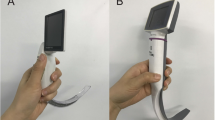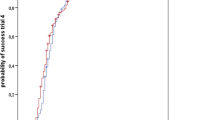Abstract
Purpose: A videolaryngoscope(VL) with an intubation conduit like KingVision channeled(KVC) blade may provide an added advantage over a non-channeled VL like a KingVision non-channeled (KVNC) blade and direct laryngoscope (DL) for acquiring and retention of intubation skills, especially in novices. Methods: In this prospective two-period randomized crossover trial, one hundred medical students used three laryngoscopes KVC, KVNC and DL for intubation following standardized training with the study devices using a Laerdal Airway Management Trainer. After one month, all participants attempted intubation, in the same manner, using all devices. The duration of intubation, modified Cormack-Lehane (CL) grade, percentage of glottic opening (POGO) score, first-attempt success, number of attempts, ease of intubation and dental trauma was recorded. The retention of intubation skills after 1 month was also assessed on the same parameters. Results: Median intubation times of KVC and DL were comparable and significantly better than KVNC (P < 0.001). The median POGO score was better with both videolaryngoscopes when compared with DL. The ease of intubation (P < 0.0012) and first-attempt success rate (P = 0.001) at the time ‘0’ was significantly better with KVC compared to KVNC and DL. KVC fared better with respect to these intubation parameters during intubation after one month as well. Conclusion: KVC performed better in terms of time to intubation, success rate and ease of procedure as compared to KVNC and DL, both for acquisition and retention of skill. Hence, we advocate that KVC should be the preferred device over KVNC and DL for teaching intubation skills to novices.


Similar content being viewed by others
References
Mulcaster JT, Mills J, Hung OR, et al. Laryngoscopic intubation: learning and performance. Anesthesiology. 2003;98:23–37. https://doi.org/10.1097/00000542-200301000-00007.
Arulkumaran N, Lowe J, Ions R, Mendoza M, Bennett V, Dunser MW. Videolaryngoscopy versus direct laryngoscopy for emergency orotracheal intubation outside the operating room: a systematic review and meta-analysis. Br J Anaesth. 2018;120:712–24. https://doi.org/10.1016/j.bja.2017.12.041.
Griesdale DE, Bosma TL, Kurth T, Isac G, Chittock DR. Complications of endotracheal intubation in the critically ill. Intensive Care Med. 2008;34:1835–42. https://doi.org/10.1007/s00134-008-1205-6.
Van Zundert A, Pieters B. Videolaryngoscopy: the new standard for intubation. Ten years’ experience. Minerva Anestesiol. 2015;81:1159–62.
Griesdale DEG, Liu D, McKinney J, Choi PT. Glidescope® video-laryngoscopy versus direct laryngoscopy for endotracheal intubation: a systematic review and meta-analysis. Can J Anaesth. 2012;59:41–52. https://doi.org/10.1007/s12630-011-9620-5.
Cooper RM, Pacey JA, Bishop MJ, McCluskey SA. Early clinical experience with a new videolaryngoscope (GlideScope) in 728 patients. Can J Anaesth. 2005;52:191–98. https://doi.org/10.1007/BF03027728.
Pieters BM, Wilbers NE, Huijzer M, Winkens B, van Zundert AA. Comparison of seven videolaryngoscopes with the Macintosh laryngoscope in manikins by experienced and novice personnel. Anaesthesia. 2016;71:556–64. https://doi.org/10.1111/anae.13413.
Okada D, Komasawa N, Fujiwara S, Minami T. Comparison of tube-guided and guideless videolaryngoscope for tracheal intubation during chest compression in a manikin: a randomized crossover trial. J Anesth. 2015;29:331–7. https://doi.org/10.1007/s00540-014-1936-1.
Chew SH, Lim JZM, Chin BZB, Chan JX, Siew RCH. Intubation with channeled versus non-channeled video laryngoscopes in simulated difficult airway by junior doctors in an out-of-hospital setting: A crossover manikin study. PLoS ONE. 2019;14:e0224017. https://doi.org/10.1371/journal.pone.0224017.
Rendeki S, Keresztes D, Woth G, et al. Comparison of VividTrac®, Airtraq®, King Vision®, Macintosh Laryngoscope and a Custom-Made Videolaryngoscope for difficult and normal airways in mannikins by novices. BMC Anesthesiol. 2017;17:68. https://doi.org/10.1186/s12871-017-0362-y.
Narang AT, Oldeg PF, Medzon R, Mahmood AR, Spector JA, Robinett DA. Comparison of intubation success of video laryngoscopy versus direct laryngoscopy in the difficult airway using high-fidelity simulation. Simul Healthc. 2009;4:160–5. https://doi.org/10.1097/SIH.0b013e318197d2e5.
Frerk C, Mitchell VS, McNarry AF, et al. Difficult Airway Society 2015 guidelines for management of unanticipated difficult intubation in adults. Br J Anaesth. 2015;115:827–48. https://doi.org/10.1093/bja/aev371.
Apfelbaum JL, Hagberg CA, Caplan RA, et al. Practice guidelines for management of the difficult airway: an updated report by the American Society of Anesthesiologists Task Force on Management of the Difficult Airway. Anesthesiology. 2013;118:251–70. https://doi.org/10.1097/ALN.0b013e31827773b2.
Bakshi SG, Vanjari VS, Divatia JV. A prospective, randomised, clinical study to compare the use of McGrath®, Truview® and Macintosh laryngoscopes for endotracheal intubation by novice and experienced Anesthesiologists. Indian J Anaesth. 2015;59:421–27. https://doi.org/10.4103/0019-5049.160946.
Murphy LD, Kovacs GJ, Reardon PM, Law JA. Comparison of the king vision video laryngoscope with the Macintosh laryngoscope. J Emerg Med. 2014;47:239–46. https://doi.org/10.1016/j.jemermed.2014.02.008.
Valencia JA, Pimienta K, Cohen D, Benitez D, Romero D, Amaya O, et al. A comparison of King Vision video laryngoscopy and direct laryngoscopy as performed by residents: a randomized controlled trial. J Clin Anesth. 2016;35:571–75. https://doi.org/10.1016/j.jclinane.2016.07.039.
Reena. Comparison of King Vision video laryngoscope (channeled blade) with Macintosh laryngoscope for tracheal intubation using armored endotracheal tubes. J Anaesthesiol Clin Pharmacol. 2019;35:359–62. https://doi.org/10.4103/joacp.JOACP_43_18.
Hirabayashi Y. Airway Scope versus Macintosh laryngoscope: a manikin study. Emerg Med J. 2007;24:357–58. https://doi.org/10.1136/emj.2006.045013.
Nouruzi-Sedeh P, Schumann M, Groeben H. Laryngoscopy via Macintosh blade versus GlideScope: success rate and time for endotracheal intubation in untrained medical personnel. Anesthesiology. 2009;110:32–7. https://doi.org/10.1097/ALN.0b013e318190b6a7.
Sakles JC, Mosier JM, Chiu S, Keim SM. Tracheal intubation in the emergency department: a comparison of GlideScope® video laryngoscopy to direct laryngoscopy in 822 intubations. J Emerg Med. 2012;42:400–5. https://doi.org/10.1016/j.jemermed.2011.05.019.
Su Y-C, Chen C-C, Lee Y-K, Lee J-Y, Lin KJ. Comparison of video laryngoscopes with direct laryngoscopy for tracheal intubation: a meta-analysis of randomized trials. Eur J Anaesthesiol. 2011;28:788–95. https://doi.org/10.1097/EJA.0b013e32834a34f3.
Maharaj CH, McDonnell JG, Harte BH, Laffey JG. A comparison of direct and indirect laryngoscopes and the ILMA in novice users: a manikin study. Anaesthesia. 2007;62:1161–6. https://doi.org/10.1111/j.1365-2044.2007.05216.x.
Lee J, Cho Y, Kim W, Choi KS, et al. Comparisons of Videolaryngoscopes for Intubation Undergoing General Anesthesia: Systematic Review and Network Meta-Analysis of Randomized Controlled Trials. J Pers Med. 2022;12:363. https://doi.org/10.3390/jpm12030363.
Lee RA, van Zundert AAJ, Maassen RLJG, et al. Forces Applied to the Maxillary Incisors During Video-Assisted Intubation. Anesth Analg. 2009;108:187–91. https://doi.org/10.1213/ane.0b013e31818d1904.
Hunter I, Ramanathan V, Balasubramanian P, Evans DA, Hardman JG, McCahon RA. Retention of laryngoscopy skills in medical students: a randomised, cross-over study of the Macintosh, A.P. Advance (™), C-MAC (®) and Airtraq (®) laryngoscopes. Anesthesia. 2016; 71:1191–97. https://doi.org/10.1111/anae.13589.
Acknowledgements
Assistance with the article: None. Financial support and sponsorship: This study received a fund of rupees 2 lakhs by AIIMS for the undergraduate mentorship program ( UG-16) in the year 2019.
Author information
Authors and Affiliations
Corresponding author
Ethics declarations
Conflict of interest
None.
Trial registration
CTRI no: CTRI/2019/10/021682.
Additional information
Publisher’s Note
Springer Nature remains neutral with regard to jurisdictional claims in published maps and institutional affiliations.
Rights and permissions
Springer Nature or its licensor holds exclusive rights to this article under a publishing agreement with the author(s) or other rightsholder(s); author self-archiving of the accepted manuscript version of this article is solely governed by the terms of such publishing agreement and applicable law.
About this article
Cite this article
Gupta, N., Kabra, P., Mandal, S. et al. Comparative evaluation of King Vision videolaryngoscope channeled and non-channeled blades with direct laryngoscope for intubation performance and skill retention by medical students: a randomized cross over two period study. J Clin Monit Comput 37, 541–547 (2023). https://doi.org/10.1007/s10877-022-00919-w
Received:
Revised:
Accepted:
Published:
Issue Date:
DOI: https://doi.org/10.1007/s10877-022-00919-w




